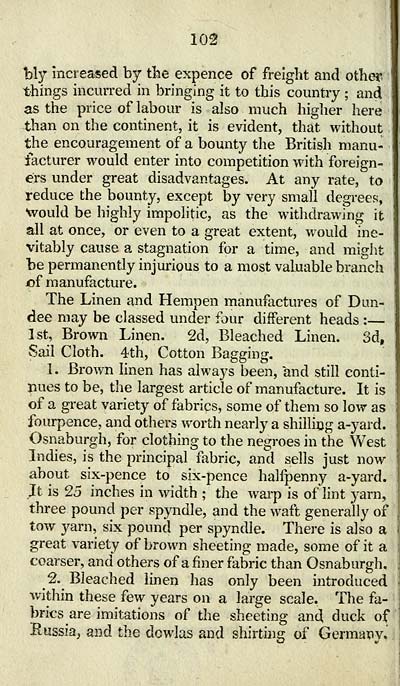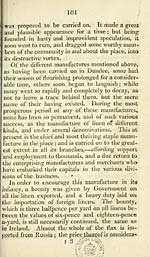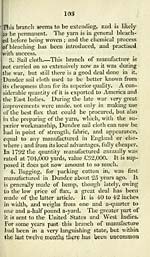Towns > Dundee > 1822 - Dundee delineated; or, A history and description of that town, its institutions, manufactures and commerce
(108)
Download files
Complete book:
Individual page:
Thumbnail gallery: Grid view | List view

102
bly increased by the expence of freight and other
things incurred in bringing it to this country ; and
as the price of labour is also much higher here
than on the continent, it is evident, that without
the encouragement of a bounty the British manu-
facturer would enter into competition with foreign-
ers under great disadvantages. At any rate, to
reduce the bounty, except by very small degrees,
Would be highly impolitic, as the withdrawing it
all at once, or even to a great extent, would ine-
vitably cause a stagnation for a time, and might
be permanently injurious to a most valuable branch
£>f manufacture.
The Linen and Hempen manufactures of Dun-
dee may be classed under four different heads : —
1st, Brown Linen. 2d, Bleached Linen. 3d,
Sail Cloth. 4th, Cotton Bagging.
1. Brown linen has always been, and still conti-
nues to be, the largest article of manufacture. It is
of a great variety of fabrics, some of them so low as
fourpence, and others worth nearly a shilling a-yard.
Osnaburgh, for clothing to the negroes in the West
Indies, is the principal fabric, and sells just now
about six-pence to six-pence halfpenny a-yard.
It is 25 inches in width ; the warp is of lint yarn,
three pound per spyndle, and the waft generally of
tow yam, six pound per spyndle. There is also a
great variety of brown sheeting made, some of it a
coarser, and others of a finer fabric than Osnaburgh.
2. Bleached linen has only been introduced
within these few years on a large scale. The fa-
brics are imitations of the sheeting and duck of
Russia, and the dowlas and shirting of Germany.'
bly increased by the expence of freight and other
things incurred in bringing it to this country ; and
as the price of labour is also much higher here
than on the continent, it is evident, that without
the encouragement of a bounty the British manu-
facturer would enter into competition with foreign-
ers under great disadvantages. At any rate, to
reduce the bounty, except by very small degrees,
Would be highly impolitic, as the withdrawing it
all at once, or even to a great extent, would ine-
vitably cause a stagnation for a time, and might
be permanently injurious to a most valuable branch
£>f manufacture.
The Linen and Hempen manufactures of Dun-
dee may be classed under four different heads : —
1st, Brown Linen. 2d, Bleached Linen. 3d,
Sail Cloth. 4th, Cotton Bagging.
1. Brown linen has always been, and still conti-
nues to be, the largest article of manufacture. It is
of a great variety of fabrics, some of them so low as
fourpence, and others worth nearly a shilling a-yard.
Osnaburgh, for clothing to the negroes in the West
Indies, is the principal fabric, and sells just now
about six-pence to six-pence halfpenny a-yard.
It is 25 inches in width ; the warp is of lint yarn,
three pound per spyndle, and the waft generally of
tow yam, six pound per spyndle. There is also a
great variety of brown sheeting made, some of it a
coarser, and others of a finer fabric than Osnaburgh.
2. Bleached linen has only been introduced
within these few years on a large scale. The fa-
brics are imitations of the sheeting and duck of
Russia, and the dowlas and shirting of Germany.'
Set display mode to: Large image | Transcription
Images and transcriptions on this page, including medium image downloads, may be used under the Creative Commons Attribution 4.0 International Licence unless otherwise stated. ![]()
| Scottish Post Office Directories > Towns > Dundee > Dundee delineated; or, A history and description of that town, its institutions, manufactures and commerce > (108) |
|---|
| Permanent URL | https://digital.nls.uk/85825327 |
|---|
| Description | Directories of individual Scottish towns and their suburbs. |
|---|
| Description | Around 700 Scottish directories published annually by the Post Office or private publishers between 1773 and 1911. Most of Scotland covered, with a focus on Edinburgh, Glasgow, Dundee and Aberdeen. Most volumes include a general directory (A-Z by surname), street directory (A-Z by street) and trade directory (A-Z by trade). |
|---|


